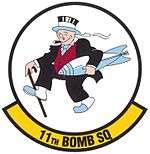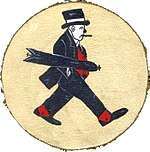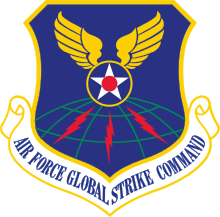11th Bomb Squadron
11th Bomb Squadron
 | |
|---|---|
 | |
| Active | 1917–1927; 1928–1945; 1954–1958; 1982–1991; 1994–present |
| Country |
|
| Branch |
|
| Type | Squadron |
| Role | Strategic Bombing |
| Part of | Global Strike Command |
| Garrison/HQ | Barksdale Air Force Base, Louisiana. |
| Nickname(s) | Jiggs Squadron or Bewilderment Group (World War I) |
| Colors | Gold and Black |
| Mascot(s) | Mr. Jiggs |
| Engagements |
|
| Decorations |
|
| Insignia | |
| 11th Bomb Squadron emblem (approved 3 March 1924)[1] |
 |
| 11th Aero Squadron emblem (approved by AEF 18 November 1918)[2] |
 |
| Tail Code | LA |
The 11th Bomb Squadron is a unit of the United States Air Force, 2d Operations Group, 2d Bomb Wing located at Barksdale Air Force Base, Louisiana. The 11th is equipped with the Boeing B-52H Stratofortress.[1]
The 11th is one of the oldest units in the United States Air Force, first being organized as the 11th Aero Squadron on 26 June 1917 at Kelly Field, Texas. The squadron deployed to France and fought on the Western Front during World War I as a Day Bombardment squadron. It took part in the St. Mihiel offensive and Meuse-Argonne offensive.[3]
During World War II the unit served in the Pacific Theater of Operations as a Boeing B-17 Flying Fortress heavy and later North American B-25 Mitchell medium bomber squadron as part of Fifth Air Force. During the Cold War it was both a tactical Martin TM-61 Matador and BGM-109G Ground Launched Cruise Missile squadron as part of the United States Air Forces in Europe.[4][5]
Mission
To provide responsive, flexible and accurate bomber combat power and expeditionary combat support to warfighting commanders.
History
World War I
- see: 11th Aero Squadron for expanded World War I history

After training in the United States, the squadron sailed for Europe on the RMS Orduna on 18 December 1917. The 11th saw combat as a day bombardment unit with First Army, 14 September 1918, which was a bloody baptism of fire. But an attempted raid the following day practically devastated the fledgling squadron. "Out of a formation of six planes which crossed the lines," remembered surviving veteran Paul S. Green, "only one succeeded in staggering back in a riddled condition." Henceforward, the 11th Squadron, earlier designated the "Jiggs Squadron" was unkindly referred to throughout the U.S. Air Service as the "Bewilderment Group." Jiggs was a cartoon character invented five years before by an 11th Squadron officer, George McManus, whose comic strip, Bringing Up Father, was the first of its kind to attract a worldwide readership. The Bewilderment Group's emblem featured the famous Jiggs with a bomb tucked under his arm. The 11th flew combat from then to 5 November 1918.
Intra-War period
With the end of World War I, the 11th Aero Squadron returned to New York Harbor. It arrived in about 30 April where it transferred to Camp Mills, Long Island the next day. There most of the men of the 11th Aero Squadron were demobilized, and returned to civilian life.
On 26 May 1919, the 11th transferred to Ellington Field, Texas, where it was manned and equipped with war surplus Dayton-Wright DH-4s. Its mission was to take part in the United States Army Border Air Patrol along the Mexican Border. Between August and November 1919, it operated from Marfa Field, and flew a border patrol along the Rio Grande between Lajitas, Texas to El Paso, Texas. It moved to Kelly Field, Texas on 8 November 1919 and again became part of the 1st Day Bombardment Group, although it remained on standby if needed along the Mexican Border.

In 1921 the Squadron was redesignated 11th Squadron (Bombardment), and in 1922 as the 11th Bombardment Squadron. Transferred on 30 June 1922 to Langley Field, Virginia, and conducted bombing tests on obsolete warships off Chesapeake Bay. The squadron was assigned to the Air Corps Training Center and transferred on 3 June 1927 to March Field, California, where it was inactivated on 31 July 1927 and its personnel transferred to the 54th School Squadron.[1][6]
Activated on 1 June 1928 at Rockwell Field, California, and assigned to the 7th Bombardment Group. Itmoved on 29 October 1931 to March Field. Conducted food relief airdrop missions to Indians snowed-in on reservations in Arizona, New Mexico, and Utah 16–21 January 1932 and for marooned miners north of Las Vegas, New Mexico, 13 February 1933. Awarded the Mackey Trophy for 1933.
Moved on 5 December 1934 to Hamilton Field, California. The 11th furnished the cadre to activate the 22d Bombardment Squadron (Heavy), on 20 October 1939. These future "Flying Falcons" operated the Douglas B-18 Bolo bomber and the Northrop A-17 attack aircraft. After gathering personnel and equipment at Hamilton Field and conducting training the units then re-equipped with the Boeing B-17 Flying Fortress, moving on to Fort Douglas, Utah on 7 September 1940, (later Salt Lake City Army Air Base). Both squadrons performed rescue and patrol duties from Fort Douglas c. 21 Jun − 13 Nov 1941.
In November 1941 the squadrons prepared for reassignment to the Philippines. The ground echelons sailed from San Francisco on 21 November with the air echelons expected to remain in the States until the ground echelon arrived in the Philippines. Before their arrival, however, the Japanese attacked Pearl Harbor on December 7, and shortly thereafter began the campaign against the Philippines.
World War II
Netherlands East Indies campaign
Following the Japanese attack on Pearl Harbor, the air echelons of the 11th conducted antisubmarine patrols along the California coast from Muroc Army Air Field, California from 8 to 12 December 1941 before moving on out into the Pacific Theater. Assigned to detached duty to the United States Navy at Brisbane, Australia, 22 Dec 1941, the squadron flew combat while operating from Hickam Field, Hawaii, 18 Dec 1941 − 5 Jan 1942
Japanese forces attacked the Netherlands East Indies at about the same time the air echelon of the 11th arrived, beginning a battle that ended in the withdrawal of United States forces in early March. During the unsuccessful defense of the Indies, the main body of the Squadron flew from Hollandia, meanwhile a detachment operated under Navy control from the Fiji Islands and then from Australia.
Major Austin A. Straubel (September 4, 1904–February 3, 1942) was commander of the 11th Bombardment Squadron and acting commander of the 7th Bombardment Group when he died from burns received in the crash of a B-18 Bolo near Surabaya, Java.[7][8][note 4]
On/about 4 March 1942 the 11th withdrew to Melbourne, Australia, where they remained for about a month. In April 1942 the squadron transferred all of their equipment and personnel to the 19th Bombardment Group.
China Air Task Force
The squadron returned to the United States in mid-1942, leaving B-17s in Australia and being re-equipped under Third Air Force as a North American B-25 Mitchell medium bombardment squadron. With the cadre units in place at Columbia Army Air Base, South Carolina, other personnel began to arrive from various parts of the U.S., by far the biggest contingent coming in from Keesler Field, Miss.
While this build-up was going on an advance cadre of the ground element of the 11th were establishing the organization in the China-Burma-India Theater (CBI). That cadre arrived at Karachi Airport, India (now Pakistan), 20 May 1942, working their way to their staging base at Allahabad Airfield, India, by 27 May, and moving on to Kunming Airport, China by 14 June. The unit was one of the first bomber units in the CBI. The aircraft were readied for flight operations by Air Technical Service Command at Karachi Air Depot and dispatched to Chakulia Airfield, India (now Bangladesh) in December.
In the middle of April, 1942, the air element of the 11th consisting of trained B-25 combat crews began to arrive at Morrison Field, Fla., as part of Project 157. Each crew was assigned an aircraft. Some two weeks were spent outfitting the B-25s, testing all the apparatus, and getting the crews accustomed to working together. The night of 2 May 1942, the first crews left for overseas, flying along the South Atlantic Ferry Route initially bound for Natal, Brazil. The B-25s were not only completely fitted and ready for immediate combat, but were loaded with a great variety of extra ground equipment for maintaining planes and crews. Every one of the planes had at least 500 pounds over the maximum weight overload for safe flight and this route had never been flown over by combat crews before, as Air Corps Ferrying Command pilots had flown Mitchells along the route only with gasoline in the fuel tanks carrying little else.
Once reaching Natal, the ferrying route to Accra in the Gold Coast was taken, then across southern Africa to Khartoum, Sudan. Then the planes were flown through Aden and followed the old British Imperial Airways route around the southern part of Arabia and Iran to Karachi. At Accra, several B-25's picked up formations of six to eight Curtiss P-40 Warhawks which had landed from a carrier. Many of these same P-40's and pilots later flew escort on missions in China. Several planes never reached India and some arrived several months after the others. By the end of May, 1942 most of the other crews of Project 157 arrived in Karachi and were assigned to the 11th Bombardment Squadron.
On 2 June 1942, six B-25s left Allahabad on a secret mission of 15 days duration. Each aircraft carried one extra crewman to act as relief during the expected two weeks' activity. This was to be the first tactical mission of the 11th Bombardment Squadron as a B-25 squadron. That night saw them at Dinjan, India, in the Assam Valley and the western end of the ferry route across the Hump into Southern China. At 0600 hours the next morning the flights took off for Kunming, China, detouring by way of Lashio, Burma. By 10 June, eight B-25s had reached their base at Kunming. The 11th Bombardment Squadron was the first United States air combat unit in China. Until their arrival, only the American Volunteer Group was flying combat missions.
Operating under the provisional China Air Task Force (CATF) at Kumming, the combat first mission in China was on 1 July 1942, against shipping in the Hankow area. No opposition of any kind was found. The next day, three ships made a return trip to Hankow, this time concentrating on the warehouse and docking facilities.
On 15 September 1942 the 11th was transferred from the 7th Bombardment Group to the 341st Bombardment Group. The 341st Group usually functioned as if it were two groups, with its headquarters and two of its squadrons, the 22d and 491st Bombardment Squadrons operating under Tenth Air Force in India and flying missions against the Japanese in Burma. The 11th, although assigned to the 341st, received its operational orders from the CATF, which later became Fourteenth Air Force.[9][10]
From several airfields in China the group engaged primarily in attacking enemy concentrations and storage areas and in conducting sea sweeps and attacks against inland shipping. They also bombed and strafed such targets as trains, harbors, and railroads in French Indochina and the Canton-Hong Kong area of China. Received a Distinguished Unit Citation for developing and using a special (glip) bombing technique against enemy bridges in French Indochina.
The 11th remained in China until the end of the Pacific War, then flying back to India and leaving its surviving aircraft in Karachi before its personnel sailed back to the United States. It was inactivated on 2 November 1945, the day after the squadron personnel debarked at Newark, New Jersey.
Cold War
The 11th Pilotless Bomber Squadron was activated in 1954 as a Martin B-61 Matador tactical missile squadron under Ninth Air Force. It was subsequently redesignated the 11th Tactical Missile Squadron on 8 June 1955, and on 1 July 1956 the 11th deployed to Europe attached to the 7382nd Guided Missile Group (Tactical) at Hahn Air Base, West Germany, assigned to United States Air Forces in Europe. It was reassigned to the 587th Tactical Missile Group, which replaced the 7382d at Hahn.
On 18 June 1958, the 11th was inactivated and replaced with the 822d Tactical Missile Squadron, with the activation of the 38th Tactical Missile Wing and the inactivation of the 701st Tactical Missile Wing.
The 11th was reactivated in 1982 as a BGM-109G Ground Launched Cruise Missile squadron at RAF Greenham Common, England. Junst before activation, it was consolidated with the 11th Bombardment Squadron. Inactivated in 1991 with the elimination of GLCMs from Europe as a result of the Intermediate-Range Nuclear Forces Treaty.
Return to bombardment operations
Redesignated as a heavy bomber squadron and equipped with Boeing B-52H s at Barksdale AFB in 1994 as part of Air Combat Command; reassigned to Global Strike Command in 2010.
Since 1994, it has trained B-52 combat crews, maintained readiness to deploy in support of national objectives, and maintained ability to sustain heavy firepower in global situations.
Lineage
- 11th Bombardment Squadron
- Organized as the 11th Aero Squadron on 26 June 1917
- Redesignated 11th Aero Squadron (Day Bombardment) on 26 August 1918
- Redesignated 11th Aero Squadron on 22 June 1919
- Redesignated 11th Squadron (Bombardment) on 14 March 1921
- Redesignated 11th Bombardment Squadron on 25 January 1923
- Inactivated on 31 July 1927
- Activated on 1 June 1928
- Redesignated 11th Bombardment Squadron (Heavy) on 6 December 1939
- Redesignated 11th Bombardment Squadron (Medium) on 15 September 1942
- Redesignated 11th Bombardment Squadron, Medium on 9 October 1944
- Inactivated on 2 November 1945
- Consolidated with the 11th Tactical Missile Squadron as the 11th Tactical Missile Squadron on 11 January 1982[1]
- 11th Bomb Squadron
- Constituted as the 11th Pilotless Bomber Squadron, Light on 17 June 1954
- Activated on 1 September 1954
- Redesignated 11th Tactical Missile Squadron on 8 June 1955
- Inactivated on 18 June 1958
- Consolidated with the 11th Bombardment Squadron on 11 January 1982
- Activated on 1 October 1982
- Inactivated on 31 May 1991
- Redesignated 11th Bomb Squadron on 24 June 1994
- Activated on 1 July 1994[1]
Assignments
|
|
Stations
|
|
Aircraft and missiles
|
|
See also
References
Notes
- Explanatory notes
- ↑ Aircraft is Boeing B-52H-175-BW Stratofortress serial 61-36.
- ↑ Note "Mr Jiggs" on each fuselage, Maulan Airdrome, France, November 1918.
- ↑ Serial 28-399 is in the foreground (tail section only). This flight of 4 aircraft completed a cross-country flight from Rockwell Field, CA to Atlantic City, NJ.
- ↑ Austin Straubel International Airport, near Green Bay, Wisconsin, is named after Austin Straubel.
- Citations
- 1 2 3 4 5 6 7 8 Robertson, Patsy (March 17, 2015). "Factsheet 11 Bomb Squadron (ACC)". Air Force Historical Research Agency. Archived from the original on September 27, 2015. Retrieved January 7, 2018.
- ↑ "World War I Aero Squadrons". Cross and Cockade Journal. Society of World War I Aero Historians. Vol. 5 (Number 2): 145. 1964.
- ↑ Gorrell
- ↑ Maurer, Combat Squadrons,
- ↑ Rogers,
- 1 2 Clay, p. 1378
- ↑ http://www.time.com/time/magazine/article/0,9171,774013,00.html
- ↑ http://www.time.com/time/magazine/article/0,9171,774351,00.html
- ↑ Group Records and Squadron History Reports, AFHRA, Maxwell AFB, AL
- ↑ Web Home of the 341st Bomb Group: Forward
Bibliography
![]()
- Clay, Steven E. (2011). US Army Order of Battle 1919-1941 (PDF). Vol. 3 The Services: Air Service, Engineers, and Special Troops 1919-1941. Fort Leavenworth, KS: Combat Studies Institute Press. ISBN 978-0-98419-014-0. LCCN 2010022326. OCLC 637712205. Archived from the original (PDF) on 27 September 2013. Retrieved 16 October 2012.
- Gorrell, Col. Edgar S. (1974). History of the American Expeditionary Forces Air Service, 1917-1919. Series E: Squadron Histories. Vol. 3 History of the 11th-13th Aero Squadrons. Washington, DC: National Archives and Records Service, General Services Administration. OCLC 215070705.
- Maurer, Maurer, ed. (1983) [1961]. Air Force Combat Units of World War II (PDF) (reprint ed.). Washington, DC: Office of Air Force History. ISBN 0-912799-02-1. LCCN 61060979. Retrieved December 17, 2016.
- Maurer, Maurer, ed. (1982) [1969]. Combat Squadrons of the Air Force, World War II (PDF) (reprint ed.). Washington, DC: Office of Air Force History. ISBN 0-405-12194-6. LCCN 70605402. OCLC 72556. Retrieved December 17, 2016.
- Mindling, George; Bolton, Robert (2008). U.S. Air Force Tactical Missiles, 1949-1969: The Pioneers. Raleigh, NC: Lulu Press, Inc. ISBN 978-0-557-00029-6. LCCN 2008908364.
- Rogers, Brian. (2005). United States Air Force Unit Designations Since 1978. Hinkley, UK: Midland Publications. ISBN 1-85780-197-0.
- War Department (1920). Battle Participation of Organizations of the American Expeditionary Forces in France, Belgium and Italy, 1917–1919. Washington DC: Government Printing Office. OCLC 118250. Retrieved December 4, 2016.
External links
- Grier, Peter (2002). "The Short, Happy Life of the Glick-Em" (PDF). Volume 85 (Issue 7). Air Force Magazine. Retrieved December 5, 2016.


